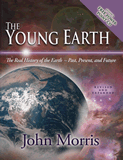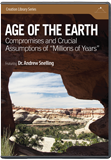
Even Earth Couldn’t Wait to Get Rid of 2020
The Earth’s Rotation Really Makes My Day
The secular change indicates that the earth-moon system is not 4.5 billion years old.
The earth’s rotation defines the day, one of the three natural divisions of time. Thus, the sun fulfills one of its purposes ordained by God (“for days” of Genesis 1:14). One would think that the earth’s rotation is constant, and indeed to a high degree of precision, it is. It was not until the late 19th century that technology had advanced to the point that astronomers could accurately measure slight variations in the earth’s rotation rate. There are many factors that affect the earth’s rotation. One factor is a tidal interaction between the earth and moon. This secular change in the earth’s rotation is very long term, and it continually slows the earth’s rotation, causing the length of the day to increase gradually. Much of what we know about the secular change in the earth’s rotation comes from historical eclipse data. Using the earth’s current rotation rate, we can calculate where eclipses in the past ought to have been visible. When we compare these predictions to historical records from a few centuries ago, the match is very good. But when we compare the predictions to medieval and ancient records of eclipses, the predicted paths lay significantly westward of the observed positions. The amount of shift is progressively greater the farther back in time eclipses were observed. This difference in longitude is due to the accumulated increase in the earth’s rotation. Study of these shifts in visibility of eclipses over the ages has given us a good understanding of the secular change in the earth’s rotation. The secular change indicates that the earth-moon system is not 4.5 billion years old.
Superimposed upon the secular change in the earth’s rotation, however, are other changes. These include seasonal changes, as well as motions deep inside the earth. Even large earthquakes, such as the December 26, 2004, magnitude 9+ earthquake that struck off the island of Sumatra, can rearrange enough of the earth to alter its rotation rate. Since the secular change always increases the length of the day but other factors may increase or decrease the length of the day, the other changes in the earth’s rotation are called periodic changes. In the short term (decades or even centuries), the periodic variations dominate the secular change. Over the past half-century, the cyclical changes have been increasing the length of the day in the same direction as the secular change in the earth’s rotation. However, that may be changing.
And You Thought Daylight Saving Time Was Complicated
People who worry about these slight irregularities in the earth’s rotation must account for these changes. For a long time, the standard of time was Greenwich Mean Time (GMT), the time as determined at the Royal Observatory at Greenwich. This was based upon the sun’s position as measured at the observatory each day, and of course GMT was a function of the earth’s rotation. By 1960, atomic clocks could keep more accurate time than the spinning earth. Some experiments and astronomical observations are so precise as to require better time measurements than GMT could offer, so new time standards were defined by atomic clocks. In 1967, the basis for time measurements was changed to an atomic standard, abandoning reliance on the earth’s rotation. There are many different standards of atomic time, so this can get a bit confusing. I’ll stick to some of the simpler ones.
Because of irregularities in both the earth’s rotation and revolution around the sun, astronomers long ago abandoned GMT in favor of Universal Time (UT) as a time standard. Universal time is based upon the positions of very distant objects in the universe that can be translated into a sort of GMT. But there are different versions of UT. The version of UT that replaced GMT as the solar day standard is UT1. Meanwhile, Coordinated Universal Time (UTC) was introduced in 1960. Shortwave radio signals, such as those of WWV in the United States, broadcast UTC. In 1960, UTC was set to match GMT. Like all modern standards of time, UTC is based on atomic clocks, though it is adjusted to match GMT, usually to the nearest second. For the first 11 years, this was done by varying the length of the second. Meanwhile, the seconds of UT1 remained constant. By 1971, the difference between UTC and UT1 was 10 seconds. Thereafter, it was decided to keep the length of UTC seconds fixed to the length of UT1 seconds and to insert a leap second whenever necessary. The rule is to insert a leap second at the end of June or December as needed. That is, when a leap second is inserted, there are 61 seconds between 23:59:00 and 00:00:00 UTC at the end of June or December. Once on New Year’s Eve, I listened to the WWV broadcast when this was done (7:00 p.m. EST), expecting some sort of announcement. There wasn’t any fanfare—if I hadn’t counted the ticks between 23:59:00 and 00:00:00, I wouldn’t have known anything unusual had happened.
A New Trend?
Prior to 2000, there was on average nearly one leap second per year (nearly the same trend as between 1960 and 1971). However, since 2000, there has been on average four years between each leap second.
Since 1972, there have been 27 leap seconds, with the last one being at the end of 2016. Therefore, the difference between UTC and UT1 now is 37 seconds. Prior to 2000, there was on average nearly one leap second per year (nearly the same trend as between 1960 and 1971). However, since 2000, there have been on average four years between each leap second. What happened? The periodic change in the earth’s rotation has decreased. A recent news report brought attention to the fact that this trend is the decreasing length of the day. The 28 shortest days ever recorded (going back to 1960) occurred in 2020. If this trend continues, rather than adding a leap second, we will need to remove a second in the next year or so. That would be a first, and it would result in the difference between UTC and UT1 being 36 seconds. There has been discussion of scrapping the practice of adding leap seconds, but it is not clear what convention would replace it. It also is not clear whether this new trend will have any impact on that decision.
With COVID-19 worldwide and the political chaos in the United States this past year, many of us were glad to see 2020 in our rearview mirrors. Now it seems that perhaps the earth itself wanted to speed up the process of ending 2020. Let us hope and pray that 2021 will be a better year.
Recommended Resources

Answers in Genesis is an apologetics ministry, dedicated to helping Christians defend their faith and proclaim the good news of Jesus Christ.
- Customer Service 800.778.3390
- © 2024 Answers in Genesis




